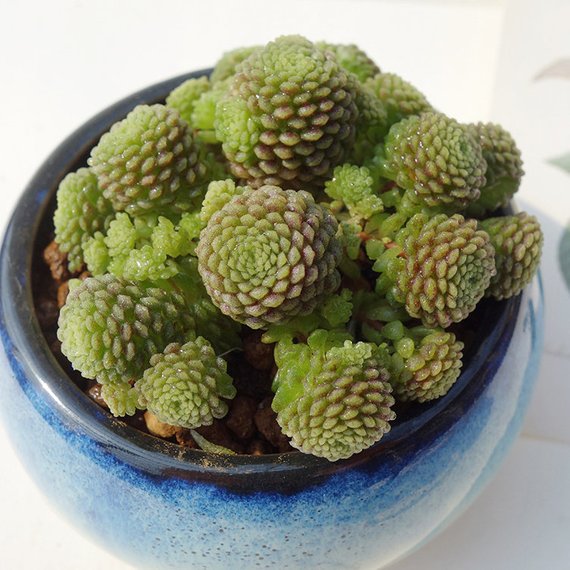The Monanthes polyphylla plant is small in size, with a height of up to 10 centimeters. It tends to grow in clusters, with stems either erect, oblique, or prostrate. The leaves are small, densely packed, giving the whole plant a lotus or tower-like appearance. The leaves are fleshy, ovate, or spoon-shaped, green in color, with some leaves turning purple or reddish-purple in environments with abundant sunlight. The small flowers bloom in early summer, with white, linear petals. Propagation is typically done by division. Spring and autumn are the growing seasons, with the plant not tolerating summer well. During the summer, it requires less watering, and shade should be provided.
Morphological characteristics:
The leaves of the Monanthes polyphylla plant are densely stacked, forming small towers, reminiscent of a pagoda. This genus of plants is extremely small herbaceous plants, with very small fleshy leaves arranged closely together, forming an ovate-spherical shape, green in color, with hairy inflorescences. The rhomboid small leaves are tightly clustered at the center, with the stem base barely visible. During the cool season, it is the peak growing season, and side buds are easily produced.
Varietal habits:
The Monanthes polyphylla plant prefers a cool, well-ventilated environment and dislikes hot and humid conditions. It is difficult to tolerate summer, as it is sensitive to high temperatures and humidity, leading to root rot. It should be placed in a cool, well-ventilated area and watered sparingly, and can be moved indoors for ventilation and care. Autumn and winter are the peak growing seasons, with side buds continuously emerging between the leaves. It can tolerate more sunlight and watering during this period. The root system of the Monanthes polyphylla plant is relatively thin and shallow. It is best not to use deep pots, and the substrate should have small, loose, and airy particles to facilitate root attachment.
Maintenance points:
Light: Requires abundant sunlight; shade should be provided in summer, and ventilation is essential.
Watering: Water sparingly, allowing the soil to dry slightly between watering, and avoid frequent watering.
Temperature: Suitable temperature range is 0-35°C, with significant temperature differences promoting coloration.
Humidity: Requires a dry and well-ventilated environment.
Fertilizer: Generally, fertilizer is not necessary, but if available, a small amount of phosphorus and potassium fertilizer can be applied.
Pests and diseases: Avoid using pesticides for home care. For minor diseases, remove the plant from the soil, dry the roots, and replant in fresh soil. For minor pest infestations, manually remove them.
Soil mix: There is no specific formula, but the soil should be well-draining, airy, and able to retain moisture appropriately.
